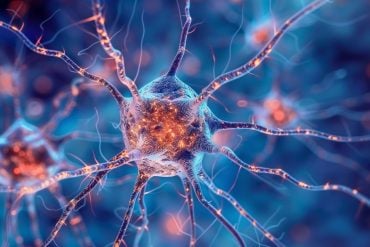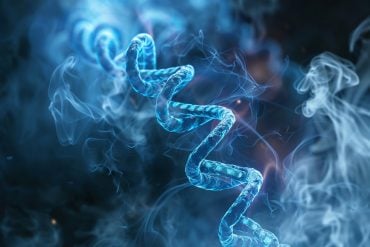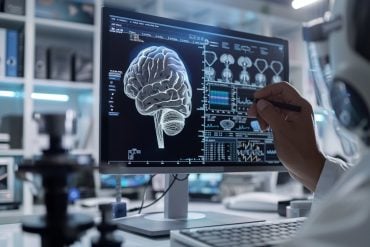Summary: A rare genetic mutation interferes with dopamine transporters in the brain, causing Parkinson’s-like symptoms in children.
Source: eLife
A rare mutation that causes Parkinson’s disease-like symptoms interrupts the flow of dopamine in the brain, suggests a study in fruit flies published today in eLife.
The findings provide more detailed insights about why young children with this mutation develop these symptoms. This new information, as well as previous evidence that therapies helping to improve dopamine balance in the brain can alleviate some symptoms in the flies, suggests that this could be a beneficial new treatment strategy.
Parkinson’s disease causes progressive degeneration of the brain that leads to impaired movement and coordination. Current treatments focus on replacing or increasing the levels of dopamine to help reduce movement-related symptoms. But these drugs can have side effects, do not resolve all symptoms, and often stop working over time.
“Although the exact cause of Parkinson’s disease remains unclear, studies of rare mutations that lead to the early onset of similar symptoms in some families have helped us learn more about possible causes, and suggested approaches for alleviating symptoms,” says first author Jenny Aguilar, a former graduate student at the Department of Pharmacology, Vanderbilt University, Nashville, Tennessee, US.
To learn more, Aguilar and colleagues studied genetically modified fruit flies with a mutation that causes a Parkinson’s disease-like condition in young children, called dopamine transporter deficiency syndrome (DTDS).
They showed that the mutation impairs the function of a so-called ‘gate protein’ that ushers dopamine from the outside of the cell inside. The mutation causes the gate protein to become stuck facing the inside of the cell more frequently, meaning that dopamine builds up outside. This slows the ability of the flies to motor coordinate their take off. “Over time, this dopamine build-up may lead to the production of less dopamine, causing worsening movement problems and other symptoms,” Aguilar says.

The team next treated the flies with a malaria drug called chloroquine, which has been shown in animals to increase the number of other proteins by preventing them from being recycled. They found that the drug helped to alleviate some of the flies’ movement problems.
While chloroquine is a widely available drug, it has side effects that make it unlikely to serve as a treatment for Parkinson’s disease-like symptoms, except in rare circumstances. This work suggests that developing treatments to improve the function of the dopamine-transporting protein may relieve movement symptoms and also stop the progressive loss of dopamine production.
“Our study provides a blueprint for using fruit flies to learn more about how problems with dopamine-transporting proteins contribute to Parkinson’s-like symptoms,” concludes senior author Aurelio Galli, Professor at the Department of Surgery, University of Alabama at Birmingham, US. “This could pave the way for further research into new treatment approaches that focus on improving dopamine transport.”
About this neurology research news
Source: eLife
Contact: Emily Packer – eLife
Image: The image is in the public domain
Original Research: Open access.
“Psychomotor impairments and therapeutic implications revealed by a mutation associated with infantile Parkinsonism-Dystonia” by Jenny I Aguilar, Mary Hongying Cheng, Josep Font, Alexandra C Schwartz, Kaitlyn Ledwitch, Amanda Duran, Samuel J Mabry, Andrea N Belovich, Yanqi Zhu, Angela M Carter, Lei Shi, Manju A Kurian, Cristina Fenollar-Ferrer, Jens Meiler, Renae Monique Ryan, Hassane S Mchaourab, Ivet Bahar, Heinrich JG Matthies, Aurelio Galli. eLife
Abstract
Psychomotor impairments and therapeutic implications revealed by a mutation associated with infantile Parkinsonism-Dystonia
Parkinson disease (PD) is a progressive, neurodegenerative disorder affecting over 6.1 million people worldwide. Although the cause of PD remains unclear, studies of highly penetrant mutations identified in early-onset familial parkinsonism have contributed to our understanding of the molecular mechanisms underlying disease pathology. Dopamine (DA) transporter (DAT) deficiency syndrome (DTDS) is a distinct type of infantile parkinsonism-dystonia that shares key clinical features with PD, including motor deficits (progressive bradykinesia, tremor, hypomimia) and altered DA neurotransmission.
Here, we define structural, functional, and behavioral consequences of a Cys substitution at R445 in human DAT (hDAT R445C), identified in a patient with DTDS. We found that this R445 substitution disrupts a phylogenetically conserved intracellular (IC) network of interactions that compromise the hDAT IC gate.
This is demonstrated by both Rosetta molecular modeling and fine-grained simulations using hDAT R445C, as well as EPR analysis and X-ray crystallography of the bacterial homolog leucine transporter. Notably, the disruption of this IC network of interactions supported a channel-like intermediate of hDAT and compromised hDAT function. We demonstrate that Drosophila melanogaster expressing hDAT R445C show impaired hDAT activity, which is associated with DA dysfunction in isolated brains and with abnormal behaviors monitored at high-speed time resolution.
We show that hDAT R445C Drosophila exhibit motor deficits, lack of motor coordination (i.e. flight coordination) and phenotypic heterogeneity in these behaviors that is typically associated with DTDS and PD. These behaviors are linked with altered dopaminergic signaling stemming from loss of DA neurons and decreased DA availability. We rescued flight coordination with chloroquine, a lysosomal inhibitor that enhanced DAT expression in a heterologous expression system.
Together, these studies shed some light on how a DTDS-linked DAT mutation underlies DA dysfunction and, possibly, clinical phenotypes shared by DTDS and PD.






